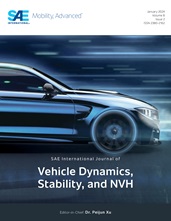Filled Rubber Isolator’s Constitutive Model and Application to Vehicle Multi-Body System Simulation: A Literature Review
- Features
- Content
- Rubber elements present highly nonlinear mechanical properties affected by frequency and amplitude of excitation, prestrain and temperature, etc. Finite element (FE) models and lumped parameter models can be distinguished in the development of constitutive models of rubbers. Based on the concept of overlay model, different kinds of viscoelastic, or frequency-dependent models, and elastoplastic/friction, or amplitude-dependent models, are compared in terms of their modelling approach, parameters identification process and applications. Prestrain-dependent models and temperature-dependent thermo-mechanical models are also reviewed, including some special models which are not based on the concept of the overlay model. Experimental and computational studies of cylindrical bushings subjected to coupled deformation modes are analyzed and discussed. It is the hope that this literature review work can help clarify and guide the future research and development direction about rubber constitutive modelling.
- Pages
- 18
- Citation
- Feng, X., Xu, P., and Zhang, Y., "Filled Rubber Isolator’s Constitutive Model and Application to Vehicle Multi-Body System Simulation: A Literature Review," SAE Int. J. Veh. Dyn., Stab., and NVH 2(2):101-120, 2018, https://doi.org/10.4271/10-02-02-0007.
